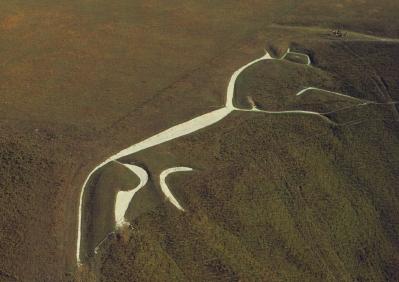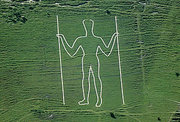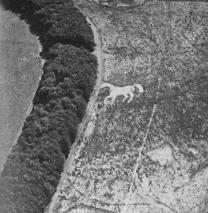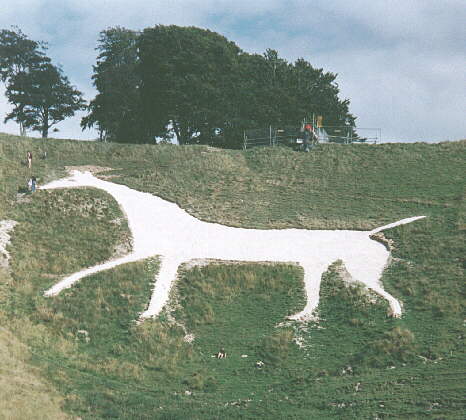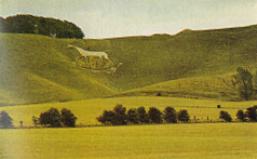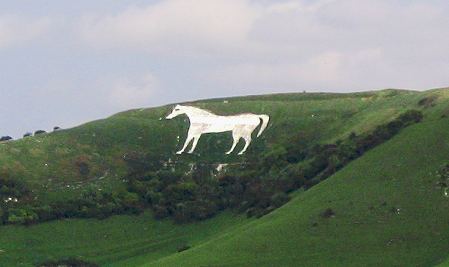|
Giants in the Landscape by Steve Johnson Galloping across the green English countryside, the Uffington White Horse is perhaps the oldest chalk figure in the United Kingdom, if not the world. At over 370 feet (112.8 metres) in length, the horse is a major landmark in Oxfordshire and probably dates back to at least 1000 BC. For centuries, the local people cleaned the chalk that defines the figure in a local tradition known as ‘The Scouring’, but that ended in the 19th century and the Horse became overgrown and almost completely obscured. Now the task of cleaning this popular tourist attraction falls on English Heritage. Although described as a horse, and indeed its design resembles stylised horses found on ancient coins, local legend tells of it being a representation of the dragon slain by St George. Some researchers have also claimed that the Horse is not an equine animal, given the protrusions from beneath its head that resemble fangs, rather than horses’ teeth. Whatever its true nature, the Uffington White Horse is certainly the most famous of our chalk figures. In Dorset stands the provocative figure of the Cerne Abbas Giant. Although thought to date from perhaps Roman times, it is now thought that this 180 foot (55 metres) carving of a man with a huge phallus may actually date from the 17th century and may even be a political parody of Oliver Cromwell! Despite this, local stories tell of a giant that was killed on the hill, with the chalk figure marking his demise. Fertility rituals have also been conducted on the hill, involving maypoles and to this day, it is said that if a childless couple make love on the carving, they will bear offspring. Recently, archaeologists discovered a part of the carving that had become obliterated over time. From the left arm of the Giant once hung a feature that may have represented a skin of some kind, suggesting that the Giant was a hunter and bolstering local claims that the figure dates back to an earlier time than the 17th century. Near Eastbourne in Sussex stands the Long Man of Wilmington. This 227 foot (69 metres) chalk carving looks out over the countryside, supporting himself with two long staffs, one in each hand. The figure is merely an outline and bears no details that may identify him, although it has been suggested that at one time, the Long Man may have had features similar to the Cerne Abbas Giant (i.e. a large phallus), but this was erased during restorations. There is no evidence for him ever having such a feature, however. The origins of the Long Man are not clear and his first mention comes from a drawing of 1710. That drawing bears little resemblance to the Man we see today, with a clearly-featured face and feet pointing away from each other, unlike today’s carving. There exists a photograph of the Long Man with his feet in such an orientation; however it is unclear whether this is a genuine photograph or some sort of hoax. In 1948, a 126 foot white horse was discovered in a field near Marlborough, Wiltshire. It became known as the Rockley (or Rockley Down) White Horse and is long since destroyed. There exists only one photograph of the beautifully-carved figure and its origin is completely unknown. It is likely that the horse is a fairly recent carving, perhaps even dating from the 20th century, although chalk carvings of horses in England reached a peak in the 18th and 19th centuries.
It was restored in 2002, however, this older photograph (above right) shows more defined edges to the carving.
These are just a small selection of some of the most well-known chalk figures in England, and I apologise for leaving out any of your favourites, such as the Alton Barnes White Horse or the Red Horse of Tysoe (which has become almost as legendary as the Uffington Horse in some circles). As we have seen, although chalk figures are something of a modern phenomenon, there are examples that the tradition stretches back far into our history and who knows what hidden, artistic treasures our landscape might reveal in the future. © 2005 Steve Johnson |
